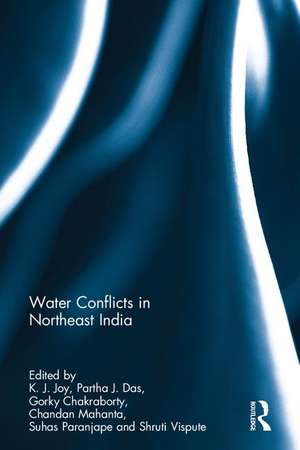Water Conflicts in Northeast India
Editat de K. J. Joy, Partha J. Das, Gorky Chakraborty, Chandan Mahanta, Suhas Paranjape, Shruti Visputeen Limba Engleză Hardback – 18 iul 2017
This volume documents the multifaceted conflicts and contestations around water in Northeast India, analyses their causes and consequences, and includes expert recommendations. It fills a major gap in the subject by examining wide-ranging issues such as cultural and anthropological dimensions of damming rivers in the Northeast and Eastern Himalayas; seismic surveys, oil extractions, and water conflicts; discontent over water quality and drinking water; floods, river bank erosion, embankments; water policy; transboundary water conflicts; and hydropower development. It also discusses the alleged Chinese efforts to divert the Brahmaputra River.
With its analytical and comprehensive coverage, 18 case studies, and suggested approaches for conflict resolution, this book will be indispensable for scholars and researchers of development studies, governance and public policy, politics and international relations, water resources, environment, geography, climate change, area studies, economics, and sociology. It will also be an important resource for policymakers, bureaucrats, development practitioners, civil society groups, the judiciary, and media.
| Toate formatele și edițiile | Preț | Express |
|---|---|---|
| Paperback (1) | 436.14 lei 6-8 săpt. | |
| Taylor & Francis – 28 mar 2019 | 436.14 lei 6-8 săpt. | |
| Hardback (1) | 1000.27 lei 6-8 săpt. | |
| Taylor & Francis – 18 iul 2017 | 1000.27 lei 6-8 săpt. |
Preț: 1000.27 lei
Preț vechi: 1219.84 lei
-18% Nou
Puncte Express: 1500
Preț estimativ în valută:
191.43€ • 199.11$ • 158.03£
191.43€ • 199.11$ • 158.03£
Carte tipărită la comandă
Livrare economică 15-29 aprilie
Preluare comenzi: 021 569.72.76
Specificații
ISBN-13: 9781138697256
ISBN-10: 1138697257
Pagini: 296
Ilustrații: 30 Line drawings, black and white; 28 Halftones, black and white; 10 Tables, black and white; 58 Illustrations, black and white
Dimensiuni: 138 x 216 x 23 mm
Greutate: 0.45 kg
Ediția:1
Editura: Taylor & Francis
Colecția Routledge India
Locul publicării:Oxford, United Kingdom
ISBN-10: 1138697257
Pagini: 296
Ilustrații: 30 Line drawings, black and white; 28 Halftones, black and white; 10 Tables, black and white; 58 Illustrations, black and white
Dimensiuni: 138 x 216 x 23 mm
Greutate: 0.45 kg
Ediția:1
Editura: Taylor & Francis
Colecția Routledge India
Locul publicării:Oxford, United Kingdom
Public țintă
PostgraduateCuprins
List of Contributors, Foreword, Acknowledgements, List of Abbreviations 1. Understanding Water Conflicts in Northeast India Part I Fault Lines 2. Damming of Rivers and Anthropological Research: An Introductory Note 3. Water Quality in Assam: Challenges, Discontentment and Conflict 4. Harnessing Energy Potential in Fragile Landscapes: Exploration of Conflicts and Emerging Issues around Hydropower Developments in Sikkim 5. Hydropower Conflicts in Sikkim: Recognising the Power of Citizen Initiatives for Socio-environmental Justice 6. State Water Policy of Assam 2007: Conflict over Commercialising Water 7. Water Conflicts in Northeast India: The Need for a Multi-track Mechanism 8. Whose River is it, Anyway?: The Political Economy of Hydropower in the Eastern Himalayas Part II Case Studies 9. Conflicts over Embankments on the Jiadhal River in Dhemaji District, Assam 10. Riverbank Erosion in Rohmoria: Impact, Conflict and People’s Struggle 11. The Char Dwellers of Assam: Flowing River, Floating People 12. Seismic Survey for Oil Exploration in the Brahmaputra River Basin, Assam: Scientific Understanding and People’s Perceptions 13. Hydrocarbon Extraction in Manipur and Its Impact on Barak Downstream 14. The Dibang Multipurpose Project: Resistance of the Idu Mishmi 15. Tipaimukh High Dam on the Barak River: Conflicting Land and People 16. Hydropower Projects on the Teesta River: Movement against Mega Dams in Sikkim 17. An Uneven Flow? Navigating Downstream Concerns over China’s Water Policy
Notă biografică
K. J. Joy is Senior Fellow, Society for Promoting Participative Ecosystem Management, Pune, India.
Partha J. Das is Head of Water, Climate and Hazard Division of Aaranyak, Guwahati, India.
Gorky Chakraborty is Associate Professor, Institute of Development Studies Kolkata, India.
Chandan Mahanta is Professor, Department of Civil Engineering, Indian Institute of Technology, Guwahati, India.
Suhas Paranjape was formerly Senior Fellow, Society for Promoting Participative Ecosystem Management, Pune, India.
Shruti Vispute is a doctoral student at the School of Geography, University of Leeds, UK.
Partha J. Das is Head of Water, Climate and Hazard Division of Aaranyak, Guwahati, India.
Gorky Chakraborty is Associate Professor, Institute of Development Studies Kolkata, India.
Chandan Mahanta is Professor, Department of Civil Engineering, Indian Institute of Technology, Guwahati, India.
Suhas Paranjape was formerly Senior Fellow, Society for Promoting Participative Ecosystem Management, Pune, India.
Shruti Vispute is a doctoral student at the School of Geography, University of Leeds, UK.
Recenzii
‘It is this kind of sound empirical research and careful deliberation on principles that can provide us the solid common ground for obviation or resolution of conflicts over water.’
Mihir Shah, Distinguished Visiting Professor, Shiv Nadar University, India
‘A must-read for all with an interest in understanding the politics and powers that mark contemporary water interventions and investments.’
Margreet Zwarteveen, Professor of Water Governance, UNESCO-IHE Institute for Water Education and University of Amsterdam, The Netherlands
Mihir Shah, Distinguished Visiting Professor, Shiv Nadar University, India
‘A must-read for all with an interest in understanding the politics and powers that mark contemporary water interventions and investments.’
Margreet Zwarteveen, Professor of Water Governance, UNESCO-IHE Institute for Water Education and University of Amsterdam, The Netherlands
Descriere
This volume documents the multi-faceted conflicts and contestations around water in Northeast India, analyses their causes and consequences, and includes expert recommendations. It fills a major gap in the subject by examining wide-ranging issues such as cultural and anthropological dimensions of damming rivers in the Northeast and Eastern Himalayas; seismic surveys, oil extractions and water conflicts; discontent over water quality and drinking-water; floods, river bank erosion, embankments; water policy; transboundary water conflicts; and hydropower development.
